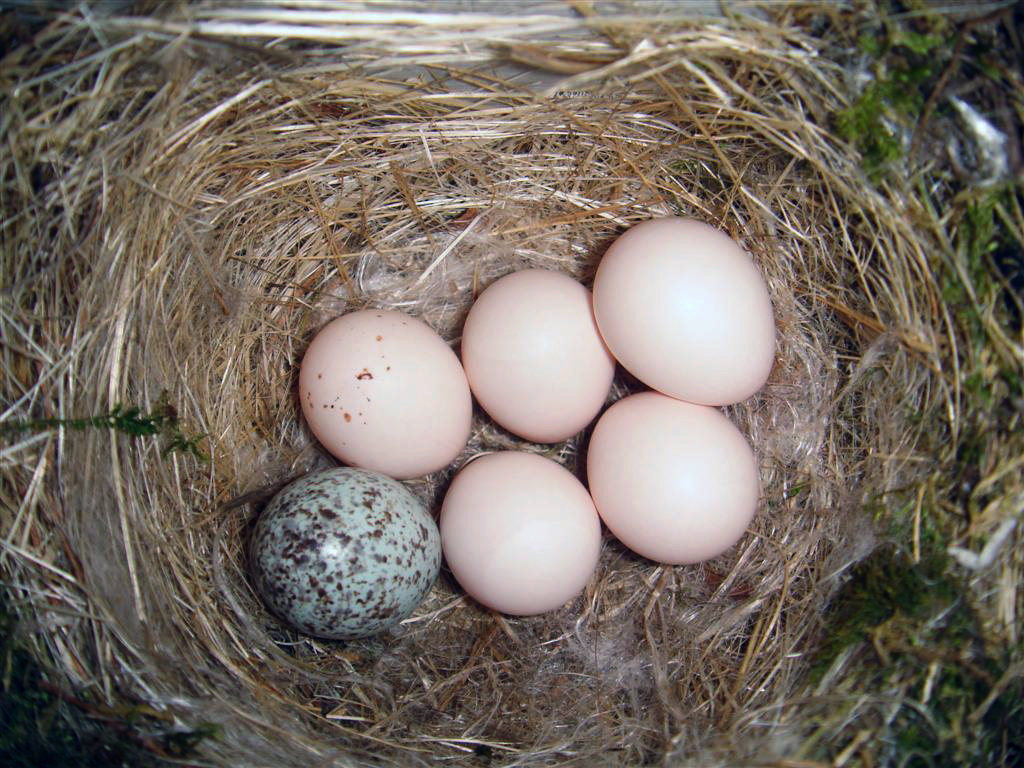Brood parasitic birds lay their eggs in the nests of host birds so as to avoid raising their own young, in turn, saving the energy and time associated with rearing offspring by passing this responsibility off to a host bird. This comes at many severe fitness costs to host birds; and as a result, hosts have developed defensive mechanisms to protect their nests from parasitic intrusions.
One defensive mechanism flips the script on P.D. Eastman’s classic question, “are you my mother?” to “are you my offspring?” where host birds must discriminate between its own eggs and foreign parasitic eggs by assessing physical features of the eggs within its clutch. Categorizing eggs as “foreign” presents its own risks though, a major one being misidentifying an egg and subsequently damaging its own offspring. Thus, many hosts are engaged in an arms race with brood parasitic birds to enhance their recognition capabilities.
Brood parasitic birds have evolved their own techniques in this arms race in order to ensure the survival of their offspring. Some brood parasitic birds, like the common cuckoo bird (Cuculus canorus), lay eggs in hosts nests that use mimetic techniques to ensure survival. The cuckoo’s eggs are extremely similar to the host’s eggs in terms of size and color. It is thought that hosts of mimetic parasitic eggs use different cognitive mechanisms that compare the phenotypic traits of eggs within their clutch. Other birds, like the brown-headed cowbird (Molothrus ater), use non-mimetic strategies in the invasion of the nest of their host, the American robin (Turdus migratorius). Non-mimetic parasitic eggs do not resemble host eggs at all.

An example of a non-mimetic parasitic egg from a brown-headed cowbird. (http://upload.wikimedia.org/wikipedia/commons/f/f9/Eastern_Phoebe-nest-Brown-headed-Cowbird-egg.jpg )

An example of a mimetic parasitic egg, top left corner. (http://sciencenordic.com/sites/default/files/imagecache/300x/Myrsanger_None.full_.jpg)
While the relationship between mimetic parasites and the effects of intraclutch egg coloration has been previously explored, this relationship is vague and relatively unstudied for non-mimetic parasites. In their study, Croston and Hauber (2015) investigate the effects of intraclutch egg color variation in American robins’ host nests parasitized by non-mimetic eggs from wild brown-headed cowbirds. They predicted that the alteration of non-mimetic egg color within the clutch would not affect the rejection rates for host robins, because there is no selective pressure towards recognizing a foreign egg when the parasite does not employ mimetic strategies.

A photo that depicts the increased egg color variation treatment group in Croston and Hauber’s study (2015).
In their study, the researchers recorded spectrophotometric data for the eggshell color in unmanipulated American robin clutches. This data was run into an avian visual modeling software to determine the degree of chromatic differences within and between robin nests based on the bird’s visual sensitivities. Additionally, Croston and Hauber (2015) examined the effects of artificially manipulating physical features of non-mimetic parasitic eggs. In one treatment group, they painted wild eggs with different shades of blue, thereby increasing color variation within the clutch, and in the other treatment group, they painted each egg with the same paint shade of blue, effectively decreasing the degree of color variation in the clutch. They then recorded the rejection rates of eggs within the manipulated nests through observation in the wild.
After analysis of their spectrophotometric data, Croston and Hauber (2015) revealed that there was a higher degree of variation in terms of egg coloration between nests than within individual clutches. Comparing the experimental treatment effects on parasitic egg rejection rates demonstrated that increasing or decreasing the intraclutch color variation levels did not impact the rejection rate significantly, supporting their original prediction. Based on these findings, the authors concluded that robins possess effective discrimination abilities that serve to identify foreign parasitic eggs, despite the fluctuating color variation that exists within its clutch. Therefore, robins, which are hosts of non-mimetic brood parasites, do not employ cognitive mechanisms that are similar to hosts of mimetic parasites. For example, eggs within robin nests vary greatly in terms of phenotypic traits, so comparing eggs within a clutch to one another would prove to be ineffective for identifying a parasitic egg. Future studies need to further examine and dissect the cognitive mechanisms that hosts of non-mimetic brood parasites employ to recognize foreign eggs, with the information provided by the research of Croston and Hauber (2015) concerning manipulating intraclutch egg color variation.
References:
Croston, R., and Hauber, M.E. (2015). Experimental Shifts in Intraclutch Egg Color Variation Do Not Affect Egg Rejection in a Host of a Non-Egg-Mimetic Avian Brood Parasite. PLoS ONE 10(4): e0121213.
